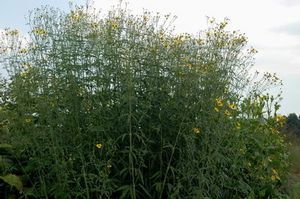Printed at http://www.newmoonnursery.com/index.cfm/
Coreopsis tripteris
Tall coreopsis
Native to North America
FIRST IMPRESSIONS: Coreopsis tripteris is a tall and stately perennial with handsome foliage and lovely yellow flowers. Leaves are arranged in opposite pairs and are deeply divided into narrow segments that appear to be odd-pinnately compound. From mid-summer until autumn the stems are topped by a glowing daisies with purple or red-brown centers. This resilient plant thrives in sunny sites with moist or mesic soil.
HABITAT & HARDINESS: Coreopsis tripteris is native to eastern North America. Plants occur in Ontario and Quebec, from Pennsylvania to the Florida panhandle and west to Wisconsin and eastern Texas.
This species is indigenous to disturbed or undisturbed sites including black soil prairies, sand prairies, savannas, open woods, stream banks, meadows, limestone glades, old fields, roadsides and railroad right-of-ways.
Plants are hardy from USDA Zones 4-9.
PLANT DESCRIPTION: Coreopsis tripteris is a robust perennial wildflower that forms colonies due to its free-seeding nature and long rhizomes.
The opposite leaves are deeply dissected into 3-5 narrow segments. Leaves on the lower half of the stem are larger and upper leaves are smaller and sometimes solitary.
The individual leaf segments are about 5” long and linear or narrowly elliptical. They are entire with a wedge shaped base and pointed tip.
The stems terminate in a striking flower display. Blooms can be solitary or arranged in large loose cyme-like clusters. They are held on graceful stalks or peduncles up to 10” long.
The individual flowers are daisy-like and about 2” across. They consist of a ring of 8 clear yellow ray florets surrounding a dense central cluster of maroon to purplish disk florets.
Plants bloom for about a month from mid to late summer into the autumn. Clusters of dark achene seed follow.
This plant is generally 4-7’ tall with a 2-8’ spread.
CULTURAL & MAINTENANCE NEEDS: Coreopsis tripteris flourishes in sun or light shade. In shade, plants tend to be open and leggy with a tendency to lean toward the sun. In open prairies or sunny garden situations plants are more floriferous and sturdier with dense foliage.
Plants thrive in loam, clay sand and gravelly soils and tolerate drought, humidity, heat and controlled burns.
This tall boy is not easily shaded out by neighboring plants. It has no serious pests but foliage is occasionally nibbled by deer.
In garden situations, deadheading will extend the bloom period and prevent unwanted seedlings.
LANDSCAPE USES: This is a good choice for Meadows, Prairies or Wildlife Gardens. Plants are also used as Accents or Butterfly Nectar Plants. This species is most impressive if planted or allowed to grow in a loose colony, Grouping or Mass. Coreopsis tripteris has Showy Blooms and is appropriate for Cottage Gardens, Water-wise Landscapes, Low Maintenance Plantings, Perennial Borders and Roadsides.
COMPANION & UNDERSTUDY PLANTS: Try pairing Coreopsis tripteris with tall prairie grasses like Andropogon gerardii, Panicum virgatum and Sorghastrum nutans. This species also mingles well with blue, purple and lavender flowering prairie species like: Aster laevis, Liatris aspera, Monarda fistulosa and Physostegia virginiana.
Heliopsis helianthoides has yellow daisy flowers and similar cultural needs and would be a suitable substitute.
TRIVIA: Flowers are frequented by butterflies, skippers and native bees. Plants host caterpillars of several moth spcies. Songbirds feast on the seed.
Height:
4-7 ftSpread:
2-8 ftSpacing:
4-8 ftUSDA Hardiness Zone:
4-9Bloom Color:
YellowCoreopsis tripteris Characteristics
Attracts Wildlife
- Songbirds
- Pollinators
- Butterflies
Attributes
- East-Coast Native
- Drought Tolerant
- Cut Flower
- Naturalizing
Exposure
- Full Sun
Deer Resistant
- Deer Resistant
Flowering Months
- October
- September
- August
Foliage Color
- Green
Salt Tolerance
- Low
Season of Interest (Foliage)
- Fall
- Summer
- Spring
Soil Moisture Preference
- Moist to Dry
Interesting Notes:
For more information on this plant, visit the USDA PLANTS Database: http://plants.usda.gov/java/profile?symbol=COTR4

